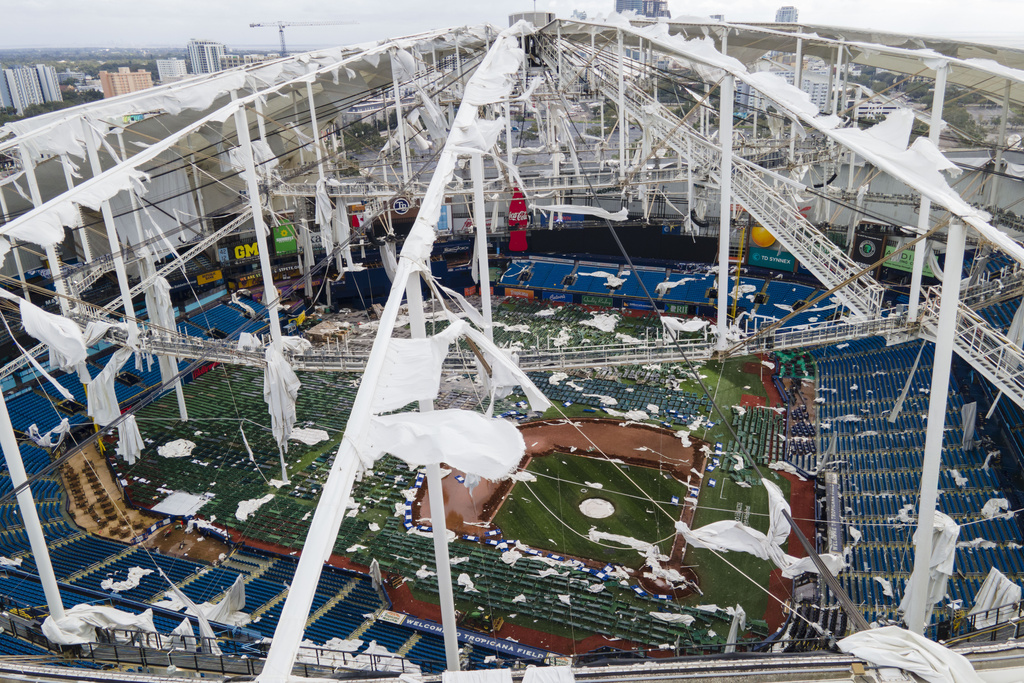Tropicana Field Repair Costs Estimated at $55.7M; Ballpark 2028 \ Newslooks \ Washington DC \ Mary Sidiqi \ Evening Edition \ A detailed assessment following Hurricane Milton shows Tropicana Field, home of the Tampa Bay Rays, can be repaired for $55.7 million and safely reopened by 2026. The St. Petersburg City Council will soon decide on moving forward with repairs amid funding challenges from recent storms and as plans advance for the new Historic Gas Plant District stadium, set to open in 2028. As repairs unfold, the Rays are exploring alternative 2025 home venues within the Tampa Bay area.
Tropicana Field Damage and Repair Plans Quick Looks
- Costly Repairs: Structural assessment estimates $55.7 million to restore Tropicana Field by the 2026 season.
- Structural Integrity: Despite extensive roof and water damage, the stadium is structurally sound and can support repairs.
- City Funding Sources: St. Petersburg expects to rely on insurance, FEMA funds, and potentially taxpayer contributions.
- Temporary Venue Options: Rays may consider local spring training stadiums, such as those in Clearwater, Tampa, and Sarasota, for the 2025 season.
- Historic Gas Plant District: Plans continue for a $6.5 billion redevelopment around a new stadium, expected to open in 2028.
Deep Look
Built in 1990, Tropicana Field has housed the Rays since their 1998 debut season, and while the stadium itself is scheduled for eventual demolition, the city remains committed to ensuring it can host the Rays in the short term as a new $1.3 billion stadium is constructed in the Historic Gas Plant District. Hurricane Milton’s damage was primarily to the fabric roof, with high winds ripping through 18 of the stadium’s 24 roof panels. Rainwater also damaged various interior sections, including seating, the press box, and the scoreboard. Hennessy Construction confirmed that the structure could support a new tension membrane roof to replace the one destroyed in the storm. The facility’s status as an important community landmark and part of the Rays’ hometown appeal has only heightened St. Petersburg’s commitment to the project.
The historic significance of Tropicana Field extends beyond sports. Located in what was once a thriving Black community known as the Gas Plant District, the stadium’s redevelopment project aims to revitalize the area by adding affordable housing, a museum, retail shops, and dining establishments, along with the new stadium expected in 2028. The $6.5 billion project seeks to pay tribute to the community’s history while offering modern amenities and a renewed neighborhood identity.
St. Petersburg Mayor Ken Welch expressed optimism about funding options, indicating that insurance and FEMA assistance could cover much of the repair expenses. “We believe having our hometown team play in St. Petersburg as soon as possible is important for our community,” he said. His statement highlights the city’s commitment to supporting the Rays as they continue to attract dedicated fans. Matt Silverman, co-president of the Rays, also voiced the team’s eagerness to work with St. Petersburg officials to develop a suitable plan moving forward.
Given that the repairs to Tropicana Field would not be completed until the 2026 season, the Rays will need a temporary home venue for the 2025 season. Major League Baseball has expressed a desire for the team to remain in the Tampa Bay area, maintaining access to its fan base. Possible temporary options include the region’s spring training stadiums, including Clearwater’s BayCare Ballpark, Tampa’s Steinbrenner Field, Sarasota’s Ed Smith Stadium, and Port Charlotte’s Charlotte Sports Park, where the Rays hold their own spring training. These venues are regularly used by major and minor league teams but would require logistical adjustments to host an MLB team for an entire season.
City officials have emphasized that any delays to redevelopment would be carefully considered to minimize disruptions. The redevelopment project is expected to create numerous jobs, enhance community resources, and boost St. Petersburg’s economy. Mayor Welch noted, “The city plans to meet its obligations to ensure that the Rays can play in St. Pete, and that the redevelopment of the Historic Gas Plant District and the construction of a new stadium move forward.” Welch’s remarks affirm that both Tropicana Field’s repair and the neighborhood revitalization are seen as priorities for the city’s future.
As the city approaches the November 21 meeting, officials are weighing the economic, cultural, and community impacts of various decisions, including the allocation of insurance and taxpayer funds, to secure the Rays’ return and advance the Gas Plant redevelopment. For the St. Petersburg community, Tropicana Field represents both a link to the past and a bridge to a revitalized future. The path forward will require careful planning, funding, and community involvement to ensure that the city’s commitments to the Rays, local residents, and economic goals are achieved in tandem.







